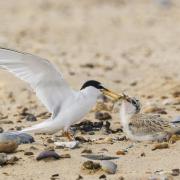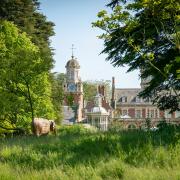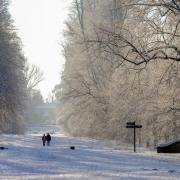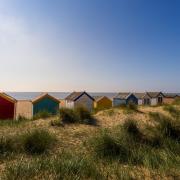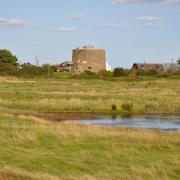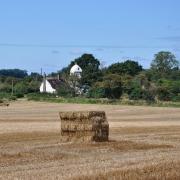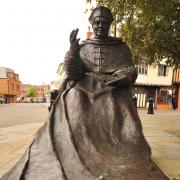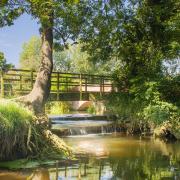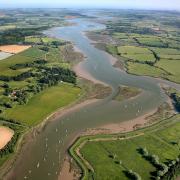Suffolk Wildlife volunteer David Jewson's role is to keep an eye on the tiny, precious nature reserve Winks Meadow in the heart of Suffolk
After 40 years, David Jewson retired from his role as a project manager for the gas distribution company Cadent, while the country was still in the grip of the first Covid-19 lockdown. As a civil engineer and surveyor, tasked with installing and maintaining much of the country’s gas pipeline infrastructure, he had frequently come up against thorny environmental conflicts, at a time when ecological surveying, as an industry, was still in its infancy.
Over the years he developed a particular interest in habitat impact mitigation: finding the least nature-intrusive way to get his job done. This often involved actions as simple as making sure excavating contractors didn’t mix topsoil with subsoil before putting it back, or liaising with local councils and stakeholders such as the Wildlife Trusts while planning pipe routes to avoid valuable natural features, such as ancient woodland, badger setts, wildflower verges or historic sites. So without really planning to, he had worked for many years as a wildlife advocate at the pit-face of conservation. "Over the years, this became the most interesting and satisfying, aspect of my work," he says.


It wasn’t far into his retirement before Dave, eager to find something worthwhile to do with all the unaccustomed free time, started looking for a volunteering role. He ended up talking to Suffolk Wildlife Trust who needed a local person to keep an eye on their tiny nature reserve, Winks Meadow, near Metfield in North Suffolk. Dave lives a 10-minute walk away in the village of St James.
Winks Meadow is a rare and pristine example of unimproved, species-rich grassland. Such habitats were still common less than 100 years ago, but have all but disappeared from the English landscape. Those that weren’t ploughed up or built over were subject to intensive fertilising and livestock grazing which, over time, has eliminated most wildflowers species and drastically reduced biodiversity.
The nearby village of Metfield was once surrounded by a patchwork of small grazing fields, hence the origin of its name, ‘Meadow Field’. But after centuries as a quiet pastoralists' backwater, the flat landscape was one of many sites across Suffolk identified as being suitable for a World War II airfield and in 1943 RAF Metfield was constructed there. The network of concrete roads and runways can still be seen among the crops that now surround Winks Meadow. After the war ended and agriculture intensified all over the country, the Metfield meadows and redundant airfield mostly succumbed to the plough. Except this one tiny three-acre field surrounded by hedges and trees that survived because the landowner, Mrs Gobbold, admired and valued the wildflowers there.



The meadow is home to scarce plants, such as sulphur clover, quaking grass and spiny restharrow, and boasts more orchid species than possibly any other natural site in Suffolk, including early-purple, twayblade, green-winged, common spotted, bee and pyramidal. In 1990 it revealed a species previously thought to be extinct in Suffolk, the frog orchid. And so Wink’s Meadow continues to this day, a remarkable island of historic biodiversity in a sea of monocultural arable farmland.
In 1989 the charity Plantlife was able to secure funding from Unilever to purchase Wink’s Meadow, already recognised by Natural England and designated a Site of Special Scientific Interest, for Suffolk Wildlife Trust. The funding was part of a conservation initiative aligned with Unilever’s shampoo brand Timotei. Many of us will remember Timotei’s iconic TV ads of the 80s and 90s depicting a young woman with long blonde hair, sometimes riding bareback on a white horse, in various natural locations, including wildflower meadows, and usually washing her hair in a clear mountain stream. I like to imagine one of their shooting locations was Winks Meadow itself, explaining their willingness to fund its purchase, but have yet to find evidence to support this hypothesis.


Rather than skipping through the wildflowers like the Timotei model, when visiting Wink’s, one must tread very lightly, sticking carefully to the few narrow rabbit paths that cross it. If you happen to stumble and place a foot off the path, you’ll probably find yourself looking with concern at the resulting footstep, hoping you haven’t squished some rare flower. In late spring particularly, it’s the kind of place where you feel you should hold your breath, so strong is the sense of preciousness and vulnerability.
Dave tells me how, when he put himself forward for the role of volunteer warden with the Suffolk Wildlife Trust, he assumed his time would be spent digging, cutting and carrying. But the main requirement at Wink’s was someone to simply keep an eye on it, to check nothing untoward happens and to observe and record species. In order to maintain the habitat, the meadow only needs occasional grazing by the trust’s small flock of Hebridean sheep, perhaps one in every four years, or more frequently a single hay cut with a drum mower in late July or early August.


Once cut, the hay is left for about five days to promote seed dispersal before being baled and removed. Sometimes the sheep will be brought in to graze the ‘aftermath’ of the hay cut and help limit the grass sward thickening. The deep hedges and their trees only need occasional attention, with a little hand trimming or laying over to keep them dense and stop their suckers spreading into the field, which one particular poplar tree on the northern boundary seems hell bent on doing. But generally the volunteer warden’s job is a sedate one.
Dave admits: "I’m no wildlife expert!" So every week for the last 18 months he has wandered around the reserve, identification book in hand, learning about the birds, bees and orchids, making careful records and becoming intimately acquainted with the denizens of Winks Meadow. From time-to-time, he’s pleased to pull up his sleeves and join work parties on other reserves where some more strenuous task is called for, but now he gets the most satisfaction from learning and sharing this knowledge. He hopes that by sharing his enthusiasm for nature, and the things we can do to protect it, he might influence others to do the same, like a local farmer who stopped mowing his verges after Dave enthused about the wildflowers on nearby roadsides. But when you think about it, this is something he’s been doing his whole working life.
Want to know more?
We’re hoping over the coming year to feature some more of the quiet heroes who selflessly give their time to support the trust’s critically important work of protecting and enhancing Suffolk’s precious natural environments and wildlife. We’ll also take a little look at some of the varied reserves where they spend their free time and, maybe, inspire others to join the movement. If you’re interested in volunteering for SWT, find out more from Gemma Foreman, the trust’s volunteer manager at gemma.foreman@suffolkwildlifetrust.org




